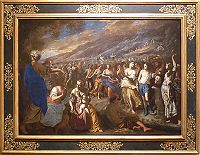
click to enlarge |
|
THE ISRAELITES CELEBRATING DAVID’S RETURN
Domenico Gargiulo
Italian 1612-1675
SN 155, Oil on canvas
From: "The Pages"
|
ARTIST:
Domenico Gargiulo, also known as Micco Spadaro,
acquired his nickname because his father was a swordmaker. He was born in Naples in 1612.
He trained in the workshop of Aniello Falcone, a specialist in battle scenes, along with
Salvator Rosa. The two spent time sketching out-of-doors in the Neopolitan countryside.
Gargiulo painted religious frescoes, & during the 1650s was acclaimed for works
chronicling Neapolitan history, including the plague of 1656 which claimed the lives of
several fellow artists.
Gargiulo was influenced by many painters; Naples being under Spanish rule, Jusepe
Ribera was a major contributor during the 1600s. The French artist Jacques Callot spurred
him to perfect genre landscapes crammed with small figures. Artists coming from Rome
spread Caravaggism.
SUBJECT:
The story of the shepherd boy David’s return from slaying the Philistine Goliath is
described in the biblical Old Testament. “When the men were returning home after
David had killed the Philistine, the women came out from all the towns of Israel to meet
King Saul with singing and dancing , with joyful songs and tambourines and lutes. As they
danced, they sang: Saul has slain his thousands, and David his tens of thousands”. (1
Samuel 18:6-7 NIV ).
PAINTING:
The work Israelites Celebrating David’s Return may have been a pendant to Toilet of
Bathsheba (Gal. 8), or they may represent two of a series about the life of the biblical
David. Israelites exemplifies the Baroque painting characteristic of busy or complex
compositions moving along diagonal lines. All motion sweeps across the canvas from the
head of the figure on the left. The figures in the middle ground are energized by twisting
garments and expressive limbs, enhanced by the muscular background landscape and
tumultuous sky. Gargiulo’s talent for adding interesting narrative details is
spotlighted in the locked gaze and similar stances of the young David and a tambourine
player, as well as the Madonna-like figure in the foreground, shushing her companion.
HISTORIC CONTEXT:
This work exemplifies the counter-Reformation movement in which the Roman Catholic church
employed the arts as a means of recapturing the public’s interest and faith in church
doctrine and scripture. The ensuing shift in pictorial style from the divine to the
emotionally and visually real, dramatic, and compelling, found its full expression in the
Baroque period.
More specifically, the story of little David overcoming the mighty Philistines may have
had a direct appeal to the Neapolitans of the day. Struggling under the absolute power of
the Spanish Hapsburgs, people of the Kingdom of Naples occasionally revolted as a result
of financial woes, a growing, poverty-stricken lower class, and a sense of isolation from
progressive Europe.
|
